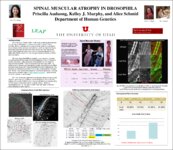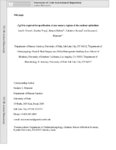Filters: Department: "Human Genetics" Collection: "ir_uspace" School Or College: "School of Medicine"
| Creator | Title | Description | Subject | Date | ||
|---|---|---|---|---|---|---|
| 101 |
 |
Capecchi, Mario R. | Hox10 and Hox11 genes are required to globally pattern the mammalian skeleton. | Mice in which all members of the Hox10 or Hox11 paralogous group are disrupted provide evidence that these Hox genes are involved in global patterning of the axial and appendicular skeleton. In the absence of Hox10 function, no lumbar vertebrae are formed. Instead, ribs project from all posterior ve... | Alleles; Animals; Forelimb; Gene Expression Regulation, Developmental; Hindlimb | 2003-07-18 |
| 102 |
 |
Capecchi, Mario R. | Xanthine oxidoreductase is central to the evolution and function of the innate immune system. | The housekeeping enzyme xanthine oxidoreductase (XOR) has been studied intensively over the past 100 years, yet the complexity of its in vivo function is still poorly understood. A large body of literature focuses on the different catalyltic forms of XOR and their importance in the synthesis of reac... | Animals; Gene Expression Regulation, Enzymologic; Humans; Immune System; Models, Biological | 2003-09-01 |
| 103 |
 |
Capecchi, Mario R. | Absence of radius and ulna in mice lacking hoxa-11 and hoxd-11. | Mice with targeted disruptions in Hox genes have been generated to evaluate the role of the Hox complex in determining the mammalian body plan. This complex of 38 genes encodes transcription factors that specify regional information along the embryonic axes. Early in vertebrate evolution an ancestra... | Alleles; Animals; Bone and Bones; Carpal Bones | 2003-09-02 |
| 104 |
 |
Gesteland, Raymond F.; Atkins, John F.; Wills, Norma M. | -1 frameshifting at a CGA AAG hexanucleotide site is required for transposition of insertion sequence IS1222 | The discovery of programmed _x0001_1 frameshifting at the hexanucleotide shift site CGA_AAG, in addition to the classical X_XXY_YYZ heptanucleotide shift sequences, prompted a search for instances among eubacterial insertion sequence elements. IS1222 has a CGA_AAG shift site. A genetic analysis re... | Hexanucleotides; Heptanucleotides; Frameshifting | 2004 |
| 105 |
 |
Gesteland, Raymond F.; Atkins, John F.; Baranov, Pavel V. | P-site tRNA is a crucial initiator of ribosomal frameshifting | The expression of some genes requires a high proportion of ribosomes to shift at a specific site into one of the two alternative frames. This utilized frameshifting provides a unique tool for studying reading frame control. Peptidyl-tRNA slippage has been invoked to explain many cases of programmed ... | Translation; Recoding; Kinetic Model; Frameshifting; Ribosome | 2004 |
| 106 |
 |
Gesteland, Raymond F.; Atkins, John F.; Howard, Michael T. | Efficient stimulation of site-specific ribosome frameshifting by antisense oligonucleotides | Evidence is presented that morpholino, 2_x0001_-O-methyl, phosphorothioate, and RNA antisense oligonucleotides can direct sitespecific âˆ'1 translational frameshifting when annealed to mRNA downstream from sequences where the P- and A-site tRNAs are both capable of re-pairing with âˆ'1 frame c... | Recoding; Frameshifting; Antisense; Morpholino; Phosphorothioate; 2_x0001_-O-methyl | 2004 |
| 107 |
 |
Capecchi, Mario R.; Tvrdik, Petr | Hoxb1 functions in both motoneurons and in tissues of the periphery to establish and maintain the proper neuronal circuitry. | Formation of neuronal circuits in the head requires the coordinated development of neurons within the central nervous system (CNS) and neural crest-derived peripheral target tissues. Hoxb1, which is expressed throughout rhombomere 4 (r4), has been shown to be required for the specification of facial... | Rhombomere 4; Branchiomotor; Cranial Nerve | 2004-07-04 |
| 108 |
 |
Moon, Ann M.; Capecchi, Mario R. | Roles of Fgf4 and Fgf8 in limb bud initiation and outgrowth. | Although numerous molecules required for limb bud formation have recently been identified, the molecular pathways that initiate this process and ensure that limb formation occurs at specific axial positions have yet to be fully elucidated. Based on experiments in the chick, Fgf8 expression in the in... | Animals; Apoptosis; Forelimb; Gene Expression Regulation, Developmental; High Mobility Group Proteins; Hindlimb; In Situ Hybridization; Mesoderm; Mice, Mutant Strains; Trans-Activators | 2004-09 |
| 109 |
 |
Hansen, Mark S.; Coffin, Cheryl M.; Capecchi, Mario R. | Pax3:Fkhr interferes with embryonic Pax3 and Pax7 function: implications for alveolar rhabdomyosarcoma cell of origin. | To investigate the role of the translocation-associated gene Pax3:Fkhr in alveolar rhabdomyosarcomas, we generated a Cre-mediated conditional knock-in of Pax3:Fkhr into the mouse Pax3 locus. Exploring embryonic tumor cell origins, we replaced a Pax3 allele with Pax3:Fkhr throughout its expression do... | Neuroprogenitor; Embryogenesis | 2004-11-01 |
| 110 |
 |
Coffin, Cheryl M.; Capecchi, Mario R. | Alveolar rhabdomyosarcomas in conditional Pax3:Fkhr mice: cooperativity of Ink4a/ARF and Trp53 loss of function. | Alveolar rhabdomyosarcoma is an aggressive childhood muscle cancer for which outcomes are poor when the disease is advanced. Although well-developed mouse models exist for embryonal and pleomorphic rhabdomyosarcomas, neither a spontaneous nor a transgenic mouse model of alveolar rhabdomyosarcoma has... | Cell Differentiation; Forkhead Transcription Factors; Myogenic Regulatory Factors | 2004-11-01 |
| 111 |
 |
Gesteland, Raymond F.; Baranov, Pavel V.; Atkins, John F.; Hammer, Andrew W. | Transcriptional slippage in bacteria: distribution in sequenced genomes and utilization in IS element gene expression | ABSTRACT: Background: Transcription slippage occurs on certain patterns of repeat mononucleotides, resulting in synthesis of a heterogeneous population of mRNAs. Individual mRNA molecules within this population differ in the number of nucleotides they contain that are not specified by the templat... | Transcription slippage; Bacterial genomes; IS element genes | 2005 |
| 112 |
 |
Gesteland, Raymond F.; Baranov, Pavel V.; Atkins, John F. | Expression levels influence ribosomal frameshifting at the tandem rare arginine codons AGG_AGG and AGA_AGA in Escherichia coli | ABSTRACT: The rare codons AGG and AGA comprise 2% and 4%, respectively, of the arginine codons of Escherichia coli K-12, and their cognate tRNAs are sparse. At tandem occurrences of either rare codon, the paucity of cognate aminoacyl tRNAs for the second codon of the pair facilitates peptidyl-tRNA... | Gene expression; Frameshifting; E. coli; Arginine codons | 2005 |
| 113 |
 |
Capecchi, Mario R. | In vivo and in vitro tissue-specific expression of green fluorescent protein using the cre-lox system in mouse embryonic stem cells. | Embryonic stem cells (ES) are pluripotent and may therefore serve as a source for the generation of specific cell types required for future therapies based on cell replacement. The isolation of defined cell populations from a certain lineage or tissue is a prerequisite for the analysis of the potent... | Animals; Cell Differentiation; Cells, Cultured; Gene Transfer Techniques; Mice, Transgenic | 2005-10-23 |
| 114 |
 |
Capecchi, Mario R. | Male fertility is dependent on dipeptidase activity of testis ACE. | Testis angiotensin-converting enzyme (ACE) is an isozyme exclusively expressed by developing sperm. This protein has only a single catalytic domain containing the HEXXH consensus-site motif typical of zinc metallopeptidases. The exact role of testis ACE is unknown, but male mice lacking the protein ... | Amino Acid Motifs; Blotting, Western; Catalytic Domain; Comparative Study; Isoenzymes; Protein Structure, Tertiary | 2005-11-11 |
| 115 |
 |
Hansen, Mark S.; Healy, Lindsey J.; Johnson, Christopher R.; Capecchi, Mario R.; Keller, Charles; Jones, Greg M. | Virtual histology of transgenic mouse embryos for high-throughput phenotyping. | A bold new effort to disrupt every gene in the mouse genome necessitates systematic, interdisciplinary approaches to analyzing patterning defects in the mouse embryo. We present a novel, rapid, and inexpensive method for obtaining high-resolution virtual histology for phenotypic assessment of mouse ... | Forkhead Transcription Factors; Paired Box Transcription Factors | 2006 |
| 116 |
 |
Gesteland, Raymond F.; Atkins, John F. | Evolutionary specialization of recoding: frameshifting in the expression of S. cerevisiae antizyme mRNA is via an atypical antizyme shift site but is still +1 | An autoregulatory translational shift to the +1 frame is required for the expression of ornithine decarboxylase antizyme from fungi to mammals. In most eukaryotes, including all vertebrates and a majority of the studied fungi/yeast, the site on antizyme mRNA where the shift occurs is UCC-UGA. The me... | Antizyme; ODC; Polyamines; Frameshifting | 2006 |
| 117 |
 |
Gesteland, Raymond F.; Atkins, John F.; Baranov, Pavel V. | Diverse bacterial genomes encode an operon of two genes, one of which is an unusual class-I release factor that potentially recognizes atypical mRNA signals other than normal stop codons | ABSTRACT: Background: While all codons that specify amino acids are universally recognized by tRNA molecules, codons signaling termination of translation are recognized by proteins known as class-I release factors (RF). In most eukaryotes and archaea a single RF accomplishes termination at all three... | Class-I release factors; RF1; RF2; Bacterial genomes | 2006 |
| 118 |
 |
Lopansri, Bert; Stoddard, Gregory J.; Hobbs, Maurine R.; Granger, Donald Lee | Elevated plasma phenylalanine in severe malaria and implications for pathophysiology of neurological complications. | Cerebral malaria is associated with decreased production of nitric oxide and decreased levels of its precursor, l-arginine. Abnormal amino acid metabolism may thus be an important factor in malaria pathogenesis. We sought to determine if other amino acid abnormalities are associated with disease sev... | Dystonia; Phenylalanine Hydroxylase; Tyrosine | 2006-06-01 |
| 119 |
 |
Rogers, Alan R. | How much can fossils tell us about regional continuity? | Presents a study on the genetic contribution of earlier populations to later populations within regions called regional continuity. Testing for regional continuity with multiple characters; Replacement of archaic population by a population of modern humans. | Human genetics; Fossils; Regional continuity | 2006-06-05 |
| 120 |
 |
Auduong, Priscilla; Murphy, Kelley J.; Schmid, Aloisia T. | Spinal muscular atrophy in Drosophila | Spinal Muscular Atrophy (SMA) is the most commonly inherited form of motor neuronal disease in humans and a leading cause of infant mortality. SMA is characterized by a loss of motor neurons which lead to muscle degeneration, paralysis, and eventual death by respiratory failure. More than ninety-f... | Trapeze Interactive Poster | 2010-03-15 |
| 121 |
 |
Mansour, Suzanne L. | Fgf10 is required for specification of non-sensory regions of the cochlear epithelium | The vertebrate inner ear is a morphologically complex sensory organ comprised of two compartments, the dorsal vestibular apparatus and the ventral cochlear duct, required for motion and sound detection, respectively. Fgf10, in addition to Fgf3, is necessary for the earliest stage of otic placode ind... | 2014-01-01 | |
| 122 |
 |
Jorde, Lynn B. | Clinical and biochemical function of polymorphic NR0B1 GGAA-microsatellites in Ewing sarcoma: A report from the Childrens Oncology Group | Background: The genetics involved in Ewing sarcoma susceptibility and prognosis are poorly understood. EWS/FLI and related EWS/ETS chimeras upregulate numerous gene targets via promoter-based GGAA-microsatellite response elements. These microsatellites are highly polymorphic in humans, and prelimina... | 2014-01-01 |
